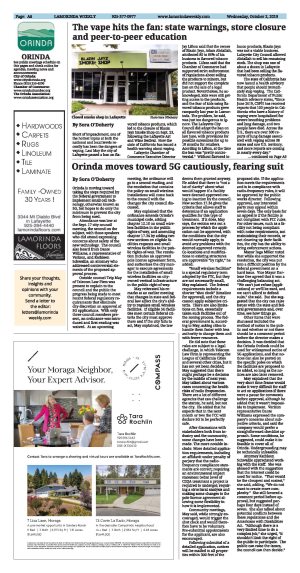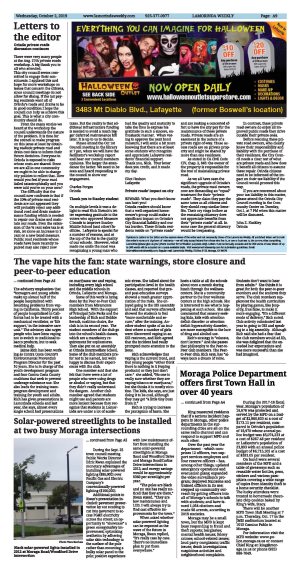| | Published October 2nd, 2019
| The vape hits the fan: state warnings, store closure and peer-to-peer education
| | | By Sora O'Doherty |  | | Closed smoke shop in Lafayette Photo Sora O'Doherty |
Short of impeachment, one of the hottest topics at both the national and local levels recently has been the dangers of vaping. Last May the city of Lafayette passed a ban on flavored tobacco products, which led to the closure of Blazin Jayz Smoke Shop on Sept. 23, following the Lafayette Art and Wine festival. Now the state of California has issued a health warning about vaping.
 Lafayette Chamber of Commerce Executive Director Jay Lifson said that the owner of Blazin Jayz, Adam Abdallah, attributed 80 to 85% of his business to flavored tobacco products. Lifson said that the Chamber of Commerce had supported strict enforcement of regulations about selling the products to minors, but did not support the complete ban on the sale of a legal product. Nevertheless, he acknowleged, kids were still getting access to the products, and the fear of kids using flavored tobacco products grew rampantly last year in Lamorinda. The problem, he said, was just too dangerous to ignore. The Lafayette City Council did adopt the ban on all flavored tobacco products last June, with provisions for possible extensions for up to 10 months for retailers. Acording to Lifson, at the time the ban was "pretty controversial." Without flavored tobacco products, Blazin Jayz was not a viable business. Lafayette City Council allowed Abdallah to sell his remaining stock. The shop was one of about a dozen in Lafayette that had been selling the flavored tobacco products.
Lafayette Chamber of Commerce Executive Director Jay Lifson said that the owner of Blazin Jayz, Adam Abdallah, attributed 80 to 85% of his business to flavored tobacco products. Lifson said that the Chamber of Commerce had supported strict enforcement of regulations about selling the products to minors, but did not support the complete ban on the sale of a legal product. Nevertheless, he acknowleged, kids were still getting access to the products, and the fear of kids using flavored tobacco products grew rampantly last year in Lamorinda. The problem, he said, was just too dangerous to ignore. The Lafayette City Council did adopt the ban on all flavored tobacco products last June, with provisions for possible extensions for up to 10 months for retailers. Acording to Lifson, at the time the ban was "pretty controversial." Without flavored tobacco products, Blazin Jayz was not a viable business. Lafayette City Council allowed Abdallah to sell his remaining stock. The shop was one of about a dozen in Lafayette that had been selling the flavored tobacco products.
 The state of California has now issued a health advisory that people should immediately stop vaping. The California Department of Public Health advisory states, "Since June 2019, CDPH has received reports that 100 people in California who have a history of vaping were hospitalized for severe breathing problems and lung damage, and two people have died. Across the U.S., there are over 500 reports of lung damage associated with vaping across 38 states and one U.S. territory, and more reports are coming in nearly every day." The advisory emphasizes that "teenagers and young adults make up almost half of the people hospitalized with breathing problems from vaping in California. Thirty percent of people hospitalized in California had to be treated with a mechanical ventilator, or `life support,' in the intensive care unit." The advisory also urges people who have been vaping not to switch to traditional tobacco products, but to seek medical help.
The state of California has now issued a health advisory that people should immediately stop vaping. The California Department of Public Health advisory states, "Since June 2019, CDPH has received reports that 100 people in California who have a history of vaping were hospitalized for severe breathing problems and lung damage, and two people have died. Across the U.S., there are over 500 reports of lung damage associated with vaping across 38 states and one U.S. territory, and more reports are coming in nearly every day." The advisory emphasizes that "teenagers and young adults make up almost half of the people hospitalized with breathing problems from vaping in California. Thirty percent of people hospitalized in California had to be treated with a mechanical ventilator, or `life support,' in the intensive care unit." The advisory also urges people who have been vaping not to switch to traditional tobacco products, but to seek medical help.
 Jaime Rich has been working as Contra Costa County's Environmental Prevention Program Director for the past 10 years. She is in charge of the youth development program and four Contra Costa County coalitions that seek to prevent underage substance use. She also leads the training team-program development and training for youth and adults. Rich has given presentations in Lamorinda schools and last year, she says, almost every single school had presentations on marijuana use and vaping, including every high school and the middle schools in Orinda, Lafayette and Moraga.
Jaime Rich has been working as Contra Costa County's Environmental Prevention Program Director for the past 10 years. She is in charge of the youth development program and four Contra Costa County coalitions that seek to prevent underage substance use. She also leads the training team-program development and training for youth and adults. Rich has given presentations in Lamorinda schools and last year, she says, almost every single school had presentations on marijuana use and vaping, including every high school and the middle schools in Orinda, Lafayette and Moraga.
 Some of this work is being done by the Peer-to-Peer Club members from Miramonte High School. With the support of Principal Julie Parks and the leadership of Rich and Debbie Berndt, coalition chairs, the club is in its second year. The student members of the club go into the school's health classes, which are a mandatory requirement for sophomores. They also put on an assembly at Orinda Intermediate School. Some of the club members prefer not to be named, but were happy to discuss their experiences with the club.
Some of this work is being done by the Peer-to-Peer Club members from Miramonte High School. With the support of Principal Julie Parks and the leadership of Rich and Debbie Berndt, coalition chairs, the club is in its second year. The student members of the club go into the school's health classes, which are a mandatory requirement for sophomores. They also put on an assembly at Orinda Intermediate School. Some of the club members prefer not to be named, but were happy to discuss their experiences with the club.
 One member said that she felt that there were a lot of people who were using drugs or alcohol or vaping, but that they didn't really understand the dangers. Another club member agreed that students might use and parents are more lenient because they recognize that students in Lamorinda are under a lot of academic stress. She talked about the participation level in the health classes, and reported that pre-and post-education surveys showed a much greater appreciation of the risks. She enjoyed going to the OIS assembly and said that surveys afterward showed the students to feel "more comfortable and secure," after the training. Another student spoke of an incident where a number of girls were discovered vaping in an OIS restroom, and Rich agreed that the incident had really prompted more attention to the issue.
One member said that she felt that there were a lot of people who were using drugs or alcohol or vaping, but that they didn't really understand the dangers. Another club member agreed that students might use and parents are more lenient because they recognize that students in Lamorinda are under a lot of academic stress. She talked about the participation level in the health classes, and reported that pre-and post-education surveys showed a much greater appreciation of the risks. She enjoyed going to the OIS assembly and said that surveys afterward showed the students to feel "more comfortable and secure," after the training. Another student spoke of an incident where a number of girls were discovered vaping in an OIS restroom, and Rich agreed that the incident had really prompted more attention to the issue.
 Rich acknowledges that vaping is the current trend, and that young people "either think there is nothing in it [vaping products] or they just don't care." she added, "No one is really sure whether they are vaping tobacco or marijuana," but she thinks it is mostly nicotine. The kids, she says, are just doing it to be cool, although they may get "a little tiny buzz from it."
Rich acknowledges that vaping is the current trend, and that young people "either think there is nothing in it [vaping products] or they just don't care." she added, "No one is really sure whether they are vaping tobacco or marijuana," but she thinks it is mostly nicotine. The kids, she says, are just doing it to be cool, although they may get "a little tiny buzz from it."
 Rich is trying to increase the perception of harm. She hosts a table at all the schools about once a month during lunch through the wellness centers. She is a community partner to the four wellness centers at the high schools. She is interested to see what is happening at each school. She also commented that sensory seeking kids, kids with attention deficit disorder or attention deficit hyperactivity disorder, are more susceptible to the lure of drug and alcohol use.
Rich is trying to increase the perception of harm. She hosts a table at all the schools about once a month during lunch through the wellness centers. She is a community partner to the four wellness centers at the high schools. She is interested to see what is happening at each school. She also commented that sensory seeking kids, kids with attention deficit disorder or attention deficit hyperactivity disorder, are more susceptible to the lure of drug and alcohol use.
 Rich's strategy is "educate, don't lecture." And she passes that philosophy to the Peer-to-Peer club members. The Peer-to-Peer club, Rich says, has "always been a dream of mine. Students don't want to hear from adults." She thinks it is great for both the peer-to-peer members and the students they serve. The club members supplement the health curriculum by playing games, like Jeopardy, true false, to make it more engaging. "It's a different mode of delivery," Rich noted. Club activity culminated last year in going to OIS and speaking in a big assembly. Although Rich said she had a fear that the club members would ad lib, she was delighted that the exceeded her expectations and was more successful than she had imagined.
Rich's strategy is "educate, don't lecture." And she passes that philosophy to the Peer-to-Peer club members. The Peer-to-Peer club, Rich says, has "always been a dream of mine. Students don't want to hear from adults." She thinks it is great for both the peer-to-peer members and the students they serve. The club members supplement the health curriculum by playing games, like Jeopardy, true false, to make it more engaging. "It's a different mode of delivery," Rich noted. Club activity culminated last year in going to OIS and speaking in a big assembly. Although Rich said she had a fear that the club members would ad lib, she was delighted that the exceeded her expectations and was more successful than she had imagined. |
| | | | | | | | | | | | |




